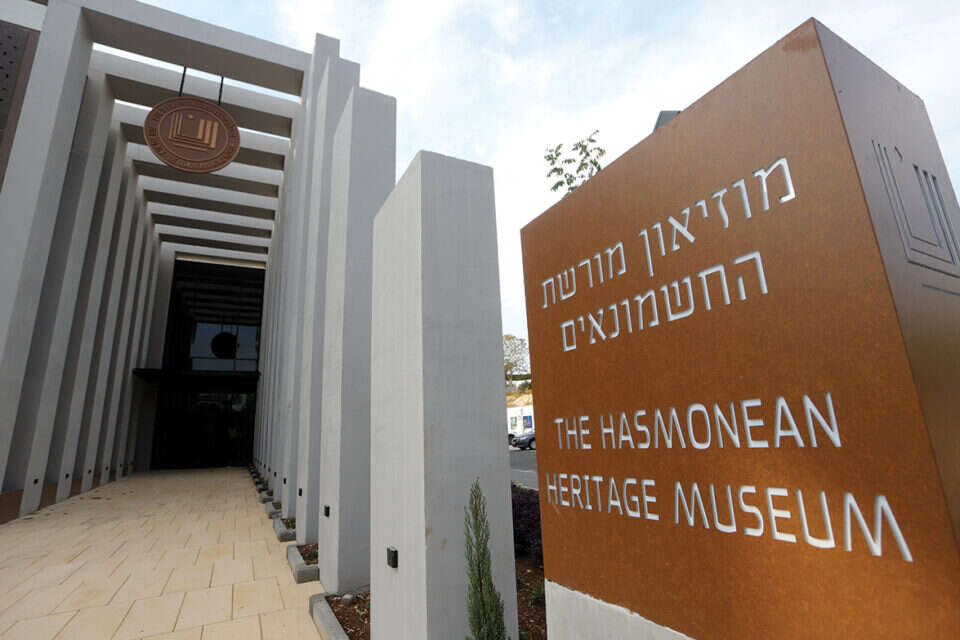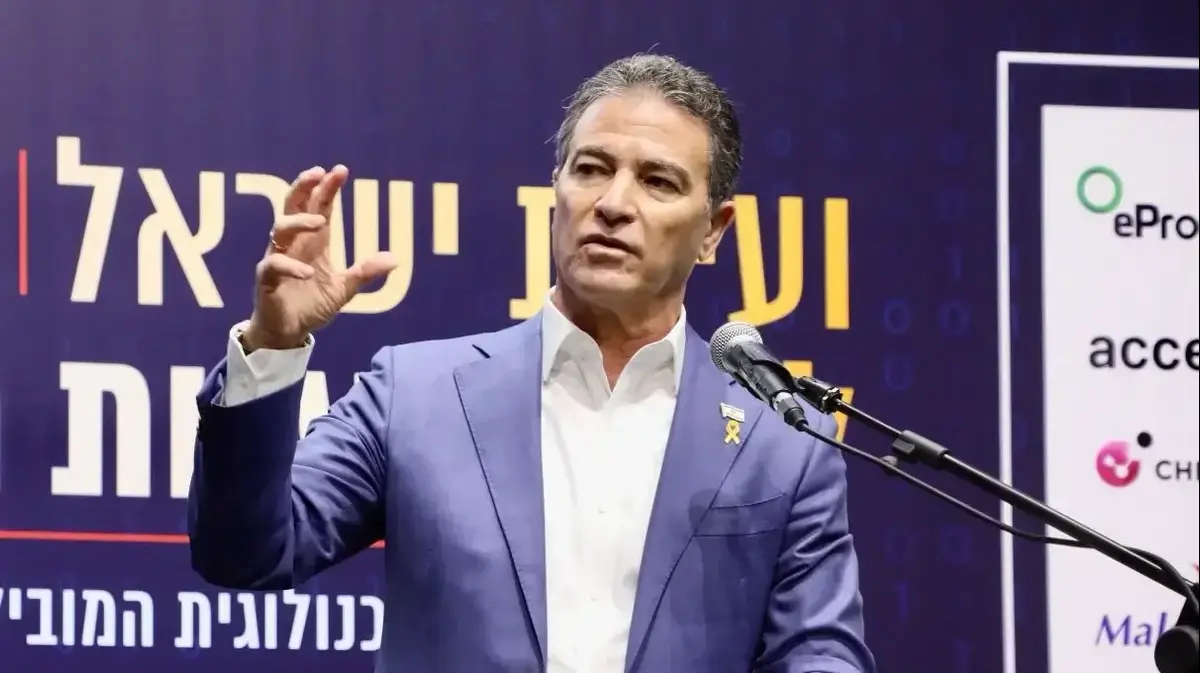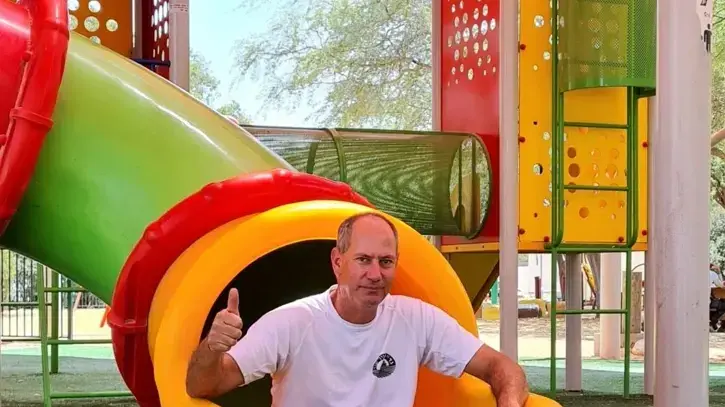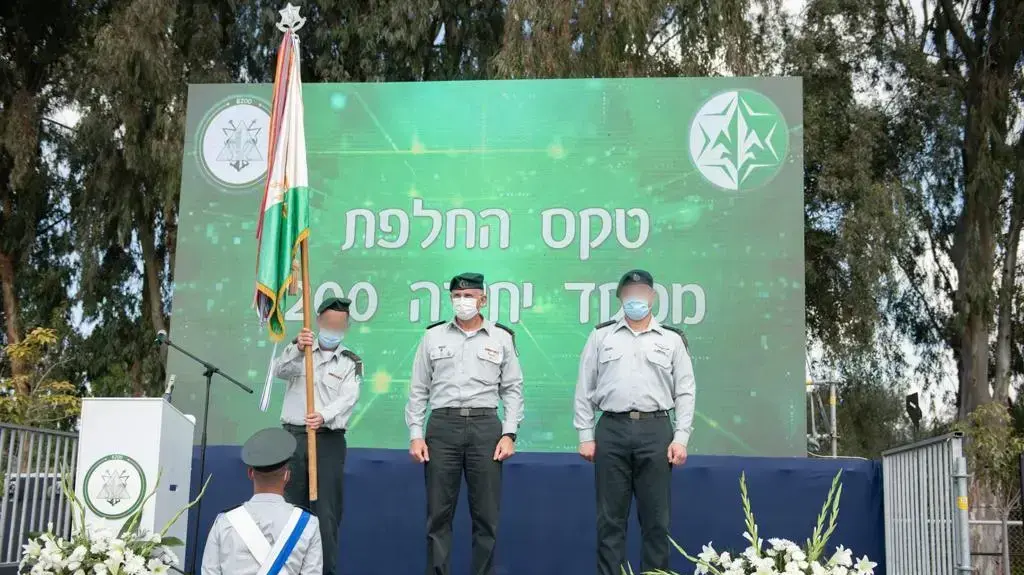About a month ago, a senior delegation from Italy arrived in Modi'in to visit the new Hasmonean heritage museum, even before it opened to the general public. After the tour, the Italians could not hide their admiration. "I'm used to presenting the archeological find with a small explanatory sign next to it, and nothing more," said one of the guests, "but you managed to do much more than that here - to revive the dry history and inspire a spirit of innovation."
The museum, built on the initiative of the Modiin Municipality, in collaboration with the Israel Antiquities Authority and with the assistance of the Ministry of Jerusalem and Heritage, is proudly located on the business and entertainment boulevard in the city center. The prominent shape of the building, which is visible from a distance, seems to suggest that it is much more than just another urban museum. "The museum draws its inspiration from the rich historical sources in the area," explains the architect Zvika Tamari, who designed it.
The museum complex embodies an ancient structure that has been "discovered", and the structure hints at "an archeological remains that originate from the ground". This special effect is achieved by lowering the pillars and beams to create a kind of street bench, which integrates with the environmental development. The skeleton of the building is built of pillars in an acceptable proportional section from the Hasmonean period, mainly Greek-Hellenistic, with a fixed distance between them, but of modern smoothed concrete. The pillars are connected by beams with a cross section similar to the creation of a simple and strong aggregate, which connects in its pattern to the classical archaeological skeleton. "As such, it is a building without walls!", Tamari declares, not forgetting to emphasize that the spaces between the pillars are used to introduce natural light around the building.
The columns are designed with narrow recesses reminiscent of the ancient connectors between the stones, and also serve as dramatic lighting grooves in the evening, in which the structure becomes a powerful icon on the main boulevard of Modiin.
The museum's finishing materials are the basic materials of construction in their nakedness: smooth concrete, oxidized steel, natural wood and aluminum, and the interior spaces created by the columns and beams are dramatic and “clean” to an ascetic level: all with the aim of being a silent and modest stage for the museum's many treasures.
Intelligence, refreshment station
Shimon Guetta, the chairman of the museum and the living spirit behind its establishment, approached the mission with Tamari and his colleagues in dismay and pity. Despite the local context, the mission to reveal the Hasmonean heritage has clear national significance. Who shaped the Jewish entity and national identity for future generations. Contemporary and worldwide.
"We have really seen before our eyes a bridge between the past and the future, a connection to the glorious history of our country," Guetta agrees.
"In all periods, without exception, there was a Jewish presence here. In Givat Barfilia alone there are no less than 260 pits - unequivocal evidence of Jewish worship and life, and the size of the settlement in ancient times. A chain of heroism and values was never interrupted, and it connects For all our activities today. "
The initiators of the museum dreamed of conveying the feeling of connection in an experiential and exciting way, with the understanding that this is the key to the hearts of the young audience.
As part of this concept, a multi-sensory interactive exhibition was placed at its center, which takes visitors on a graceful journey through time to Hasmonean intelligence.
To the presentation are added computer operating positions and thematic positions, in which the content can also be experienced through all the senses.
One corner resembled a typical Jewish burial cave;
Another corner will showcase the art of healing and allow you to experience the work of archaeologists while guidedly assembling storage vessels from potsherds.
Next week, after a run-in period, the museum will officially open its gates at a festival celebration.
This will inevitably happen during Hanukkah, the Hasmonean holiday - another symbolism that joins a long line of symbolic expressions in the museum's contents, structure and process of its establishment.
One of the strongest in which the visitor meets in the foyer: a huge map of ancient intelligence, and right on it, corresponds with it, the map of the new intelligence.
Want to know what the modern city was like thousands of years ago?
Just click the button that intrigues you in the timeline.
If you choose the Early Bronze Age, for example, you will find that precisely in the area of today's Buchman neighborhood there was an ancient settlement known as Horbat Hadad, and its population processed agricultural products, collecting them in hewn pits.
The statue in the image of God,
"Modi'in was on her own on the way from the coastal plain to the mountain plain and later to Jerusalem," says Guetta. "As Umm al-Umdan, and restored a few years ago on its mikvahs, it is not difficult to imagine."
The diggers who uncovered the Umm al-Umdan site in southwest Modi'in, along the Hasmonean Boulevard road leading to the city's southern entrance, are convinced: this is Hasmonean intelligence. Remains of a Jewish village from the Second Temple period were found here, including a system of alleys, residential buildings, a synagogue and a mikveh tehara. This is one of the few synagogues from the Second Temple period known today, which operated during the existence of the Temple in Jerusalem - it is the oldest of them, and dates back to the Hasmonean period. Outside the village, many installations were identified that indicate the agricultural nature of the settlement: winepresses, columbariums and cisterns. It is speculated that the settlement existed continuously even in the Roman period, and was probably abandoned during the second century CE, after the Bar Kochba revolt.
"The finds that were discovered in Modi'in over the years, some even before it was built and some during the years of the city's existence, were returned home," says Guetta.
"The museum displays more than 150 ancient items that tell the story of the place from prehistoric times to the present day. We continue to conduct community excavations with the participation of the residents, especially the city's children, and we are no doubt expecting more extraordinary discoveries."
The treasure not collected
It is not known when new discoveries will be made, but even now the Museum of the Hasmonean Heritage can be proud of some impressive exhibits, the study of which brings up interesting connotations in the context of the Maccabees.
Among other things, you will find fresco decorations from the synagogue in Umm al-Umdan, which are decorated with a marble-like pattern that is identical to the decoration of the affluent houses in the upper city of Jerusalem, where the priesthood families lived during the Second Temple period.
The man who started the revolt against the Seleucid kingdom and rule of Antiochus IV, Matityahu ben Yochanan Cohen Gadol from the Hasmonean family, is known to have come from this family.
Not far from the spectacular decorations are two stone seals - the first bears an Aramaic inscription with the word "butter", meaning vinegar, and the second is decorated with a plant pattern, with vine leaves and grape clusters. Below is an ossuary bearing an Aramaic inscription, written in black ink, indicating the name Shimon ben Elazar. The names Shimon and Elazar ring familiar to anyone familiar with the Chanukah story - Shimon Hatarsi and Elazar Hahorni were the sons of Matityahu HaCohen - but Meirav Shai, the museum's future director, is quick to cool the enthusiasm (may we have found an item attributed to the legendary dynasty and rebellious leaders)? Most in Jewish society during the Second Temple period.
When Guetta is asked what he thinks is the most exciting find among the exhibits in the museum, he does not hesitate: "This is a rare treasure trove of coins from the Hasmonean period, which was unearthed in Horbat Ashon: 16 silver coins, tetrahedrons and dichotomies (NIS 1.5) between the years 135-126 BC" S. and bear the figures of King Antiochus VII and his brother Demetrius II.
In the Hasmonean period there was a handsome agricultural estate here, the main strike was built of solid walls, to provide security from conquests and bandits.
The treasure belonged to a Jew who hid his money in the hope of collecting it again later.
Who knows what happened to him?
Maybe he was a fighter in the Hasmonean army?
It is clear that the course of his life did not go according to plan, and he did not return to take the coins, which had been waiting for more than two thousand years tucked in a crevice of rock near the wall of an estate.
"About 2,140 years later, before we set about building a new neighborhood in the city, we initiated an excavation in collaboration with students, and we were privileged to receive an expensive greeting from our past, literally."
The archaeologists who accompanied the excavation at Horbat Ashon came to the conclusion that the agricultural estate was established by a wealthy Jewish family.
The family members planted olive trees and vines on nearby hills, and grew grain in the valleys.
Near the mansion, an "industrial area" typical of the period was exposed, with a cloth house that was used to produce olive oil and warehouses for oil storage.
Dozens of rock-hewn winepresses were uncovered in the agricultural plots near the estate, which indicate the cultivation of the vine and the wine industry in the area.
In addition to the treasure, many bronze coins minted by the Hasmonean rulers were found in Horbat Ashon, bearing the names of the rulers of the dynasty (Yochanan Yehuda, Yehonatan or Matitya) and their titles - Cohen Gadol and Rosh Hever Yehud.
"The torch is burning."
Guetta, Photo: Photo: Jorge Nomkowski
Activities at the estate continued throughout the Early Roman period, but evidence of settlement in later periods was also found at other sites throughout Modiin.
Thus, for example, in Givat Titura, in a strategic and high location, traces of life were discovered from the Chalcolithic period to the Crusader period.
"In a Crusader fortress that was on the hill, cooking pots, jars, serving utensils and even food scraps were found," Guetta notes, "and with them many pieces of silver and bronze jewelry. A residential neighborhood, whose name, how symbolic, is a heritage neighborhood. "
Greetings from Egyptian mythology
The curatorial work of the new museum was overseen by Edna Aish and Noyat Popovich, archaeologists from the Israel Antiquities Authority, who were greatly assisted by their colleague Avraham Tendler, who conducted many excavations in Modi'in and the surrounding areas. "In this aspect, we decided, despite the temptation, to be local," explains Aish. "That is, to display only the finds discovered in the city and its outskirts. Fortunately, there are so many excavation sites, and each one provides something unique and valuable. For example, from the excavations at Givat Zechariah we bring altars to stone house worship, from the Persian and Hellenistic period. Found in Horbat Ashon - a figurine made of bronze in the form of the Egyptian god Horus, a symbol of the Egyptian monarchy and one of the main gods in Egyptian mythology.
"The research on the object is still ongoing, and its date is uncertain at this stage, but some things are certain. First, its presence in our area indicates trade relations that existed with Egypt in ancient times. Were common here. "
Popovich emphasizes the importance of another find - a modest-looking (worship vessel) that dates back to the Iron Age discovered at Givat Titura. She speculates that the object was probably used by the locals in Jewish worship, and adds that in the famous Lachish reliefs, similar objects are seen, carried by the exiles who leave the Land of Israel following Sennacherib's journey.
"The museum is building another important pillar in commemorating the heritage of the Jewish people," Guetta concludes. "We continue to hold the torch of the Hasmonean heritage. Ancient intelligence has preserved this legacy. The torch continues to burn in the new intelligence."
In honor of Hanukkah and the opening of the museum, a series of unique events will be held during the holidays, including an innovative escape challenge called "The Hasmoneans are coming!", Clay candle making workshops, Hasmonean costume activities, a mosaic Hashmonaim and a lecture on the phenomenon of antiquities in Israel.
Were we wrong?
Fixed!
If you find an error in the article, we will be happy for you to share it with us and we will correct it









